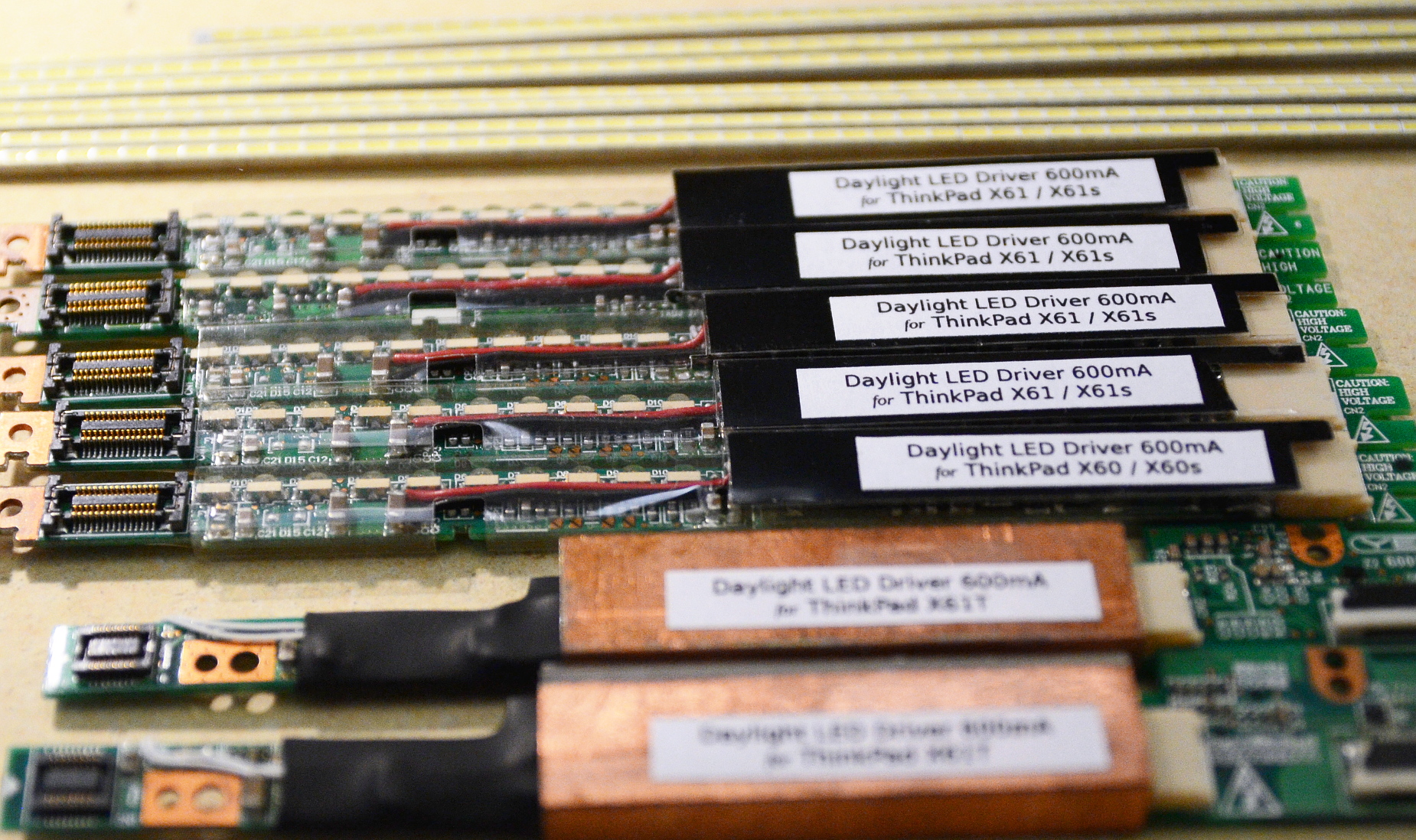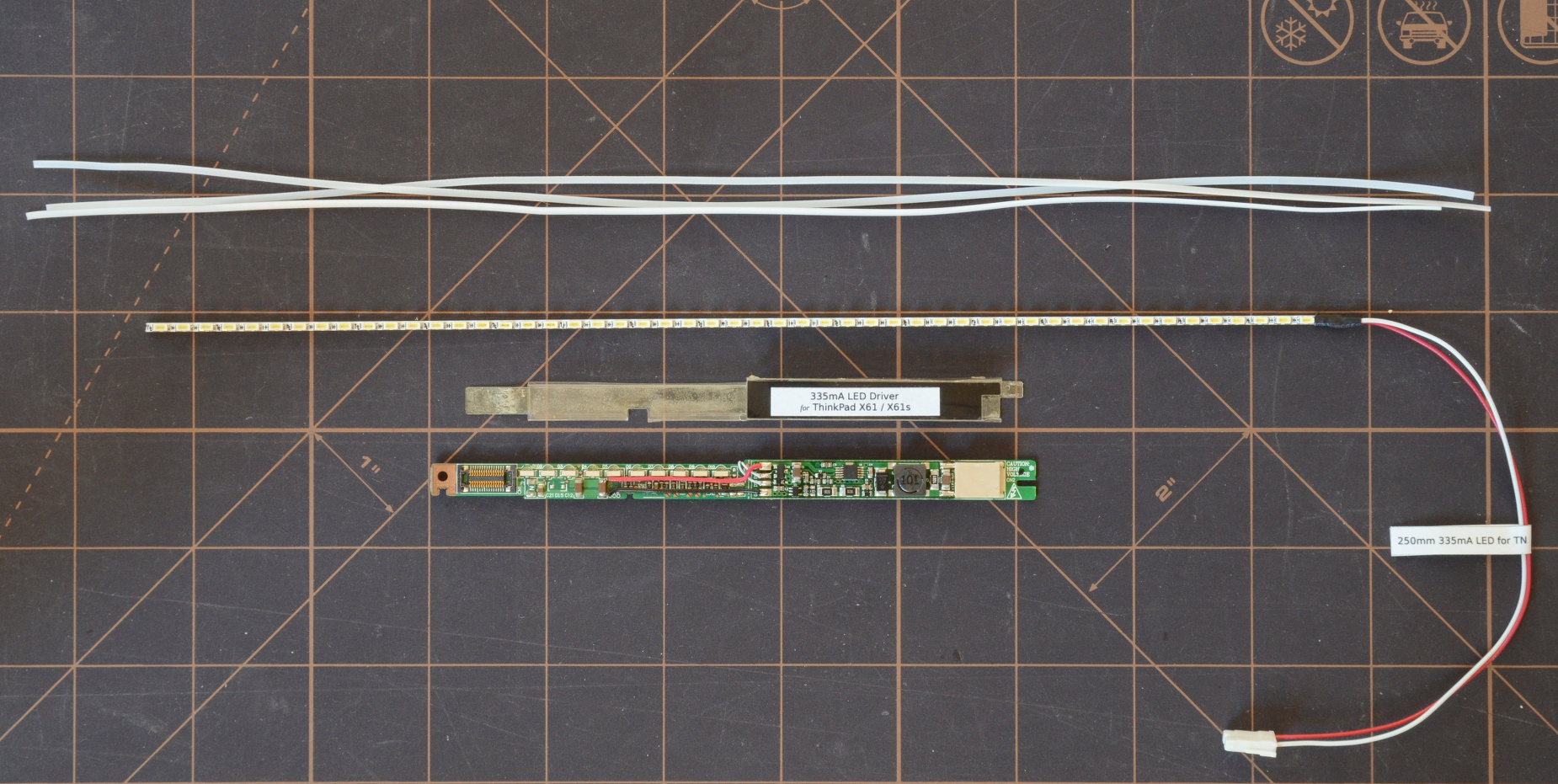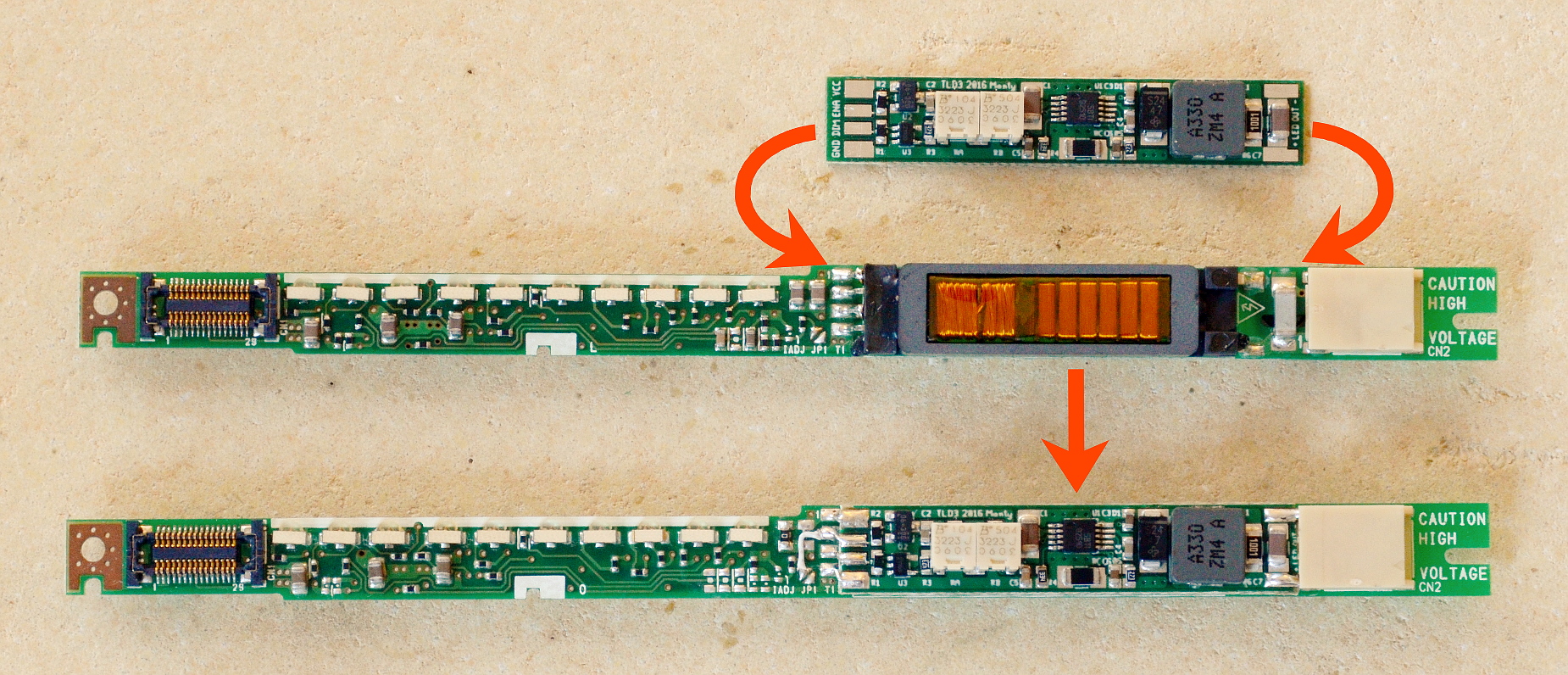

 Everything Needed
Everything NeededConverting a CCFL-equipped ThinkPad to use an LED backlight requires an LED backlight driver to replace the CCFL inverter and an LED backlight strip to replace the CCFL tube. It's also useful to have some thin plastic shims to fit the LED strip snugly in place.
The conversion kits below include all three items, which are also available as individual parts. The parts and kits come in two basic flavors: the 'Original' kit and the new 'Daylight' kit. From there, the needed LED driver also depends on the model of ThinkPad.
 Original kit
Original kitOriginal-version kits are available for the X41, X41T, X60, X60s, X60T, X61, X61s and X61T.
The Original kit uses a decent Chinese white LED strip paired with one of my own driver boards. The driver and LED strip are matched for a max output of 335mA, the rated limit of the LED strip. At full brightness, the LED strip uses 3.2W.
This kit is recommended for TN screens and will also work well with AFFS XGA screens. It is not recommended for SXGA screens, as most HV121P01-100 and HV121P01-101 will show a rippling mirrored pattern from individual LEDs along the bottom inch or so of the screen. SXGA screens require a Daylight kit, which eliminates the rippling pattern.
 Daylight kit
Daylight kitDaylight kits are available for the X41, X41T, X60, X60s, X60T, X61, X61s and X61T.
The Daylight kit is an upgrade intended for XGA and SXGA AFFS screens (i.e. "the really nice screens"). It pairs the new range-adjustable TLD3 driver board with a custom LED strip using Nichia's latest-generation component-phosphor LEDs designed specifically for backlights. It's two to three times as bright as the Original kit with substantially improved gamut coverage exceeding the original CCFL.
The Nichia LEDs also allow Daylight kits to run at a higher 600mA current compared to the Original kit. At full brightness the LED backlight uses 4.8W.
The use of closely-packed, wide-angle, low-profile LEDs along with an accordian shim eliminates the 'rippling' pattern seen along the bottom of SXGA screens when using other strips.
 Individual backlight drivers
Individual backlight driversLED backlight drivers are made by fitting custom LED driver boards to existing ThinkPad inverter PCBs in place of the CCFL step-up coil. This strategy leaves all the other functionality of the inverter board completely in-tact. The indicator LEDs still work, as do the sensors and pushbuttons on the tablet models.
I currently use three different driver boards, imaginatively named ThinkPad LED Driver 1, ThinkPad LED Driver 2, and ThinkPad LED Driver 3.
TLD1 and TLD2 were the original test prototypes (which turned out to work well.) TLD3 is an update of the TLD1 layout adding two surface mount potentiometers that allow easy adjustment of the brightness range and step spacing.
The TLD1, TLD2, and TLD3 boards are available alone or pre-mounted to a ThinkPad inverter PCB.
 Individual LED backlight strips
Individual LED backlight stripsThe 'Original' LED strips are Chinese white-LED strips originally bought in a large batch through iCCFL.com. I measured each strip with a spectrometer and divided them by whitepoint into 'good for TN' (warmer / higher CIE Y coordinate value) and 'good for AFFS' (colder / lower CIE Y coordinate value). I don't intend to stock more once these are all gone, as the color-suitability of Chinese strips is so hit-or-miss.
The 'Daylight' LED strips are all made from the same bin of Nichia NSSW157F-HG LEDs. The output spectrum is suitable for all AFFS screens. Colors will also be good with TN, though slightly cold (about 7500-8000K).
Original strips for 4:3 12.1" screens are trimmed to 250mm of lit area. Daylight strips are a slightly shorter 246mm to prevent bright corners on SXGA screens.
The plastic shims used in these kits are simply 1.5mm by ~300mm strips of Teflon or Mylar-D; any plastic with a working deformation temperature above 100C is appropriate.
The thin shim strips are approximately 10-mil (.25mm) thick and the thicker strips approximately 30-mil (.75mm). Accordian strips are 5mil (.125mm) mylar cut along the grain, and folded into an accordian with bends approximately a centimeter apart.
I'm happy to send shim strips (and they're included in the kits), but these materials should be available from any good hobby or modeling shop.
 Part Prices and Ordering
Part Prices and OrderingPrices above do not include shipping. Domestic first-class postage within the USA is currently an additional $2.45 and now includes tracking. International first class is $13.50 without tracking; International registered mail with tracking is $27.45. Up to five kits fit in a single box.
Please contact me to place an order, even if you already know my PayPal address. I make these parts on-demand, so I want you to be aware of any backlog. I'm also happy to make custom versions of parts, as well as longer LED strips for other screens. Be sure to let me know exactly what parts you want, Original or Daylight, and what ThinkPad model.
Exhaustive installation instructions are on the Installing LED Backlights into Thinkpad LCDs page. The instructions cover multiple screens and ThinkPad models, as well as general installation tips for modders making their own custom kits.


It depends on the screen and the kit. Using the same LED strip, TN screens are brightest, followed by the XGA AFFS screens, followed by the SXGA screens.
An Original kit can be expected to hit 400 nits in a TN screen and about 300 nits in an XGA AFFS screen. A Daylight kit will exceed 800 nits in an XGA screen, and reach somewhere between 550 and 750 nits in an SXGA screen depending on how the strip is fitted.
An Original kit produces less saturated colors than the original CCFL backlight. Reds especially become somewhat muted. The screen will not look especially odd, but it will look noticably less colorful.
A Daylight kit produces significantly better color than the original CCFL, and comes much closer to ideal coverage of the standard sRGB gamut, especially with AFFS screens.
No. The LED driver board converts the ThinkPad's PWM brightness control signal to an analog level that regulates the LED current. The LEDs are powered by a steady, continuous current across the entire brightness range.
Yes. The status LEDs are unaffected by an LED upgrade.
Yes. The custom driver boards are designed to use native ThinkPad brightness signaling.
LEDs are so much brighter than CCFLs that it's important to make the brightness range and spacing as useful as possible. For example, we don't want the minimum brightness to be too bright to use comfortably in dim lighting.
CCFL ThinkPads all use the same brightness control system, but different ThinkPads use different brightness ranges and step spacing. The X60, for example, uses a relatively narrow, exponentially spaced brightness range with 8 steps. The X61 uses a different, wider, 16-step linear spacing.
These spacings were designed to work with specific CCFL lamps. LEDs behave differently, especially at low brightness levels. As a result, the LED driver boards must be 'trimmed' for the best behavior with a given model's brightness range.
TLD1 and TLD2 boards are trimmed by soldering approriate resistors into the level translation circuit, so they're assembled for specific ThinkPad models. The TLD3 board can be trimmed for any model via two potentiometers, but it's still shipped out pre-adjusted for a given model.
TLD3 should be more physically robust to rough handling, but it functions exactly the same.
The main difference is that the TLD1 and TLD2 boards must be adjusted by desoldering and replacing trimming resistors, where the TLD3 is adjusted via two potentiometers.
Go for it! Feel free to use and improve these designs any way you wish. If you want to make and sell parts (and save me the trouble), be my guest!